Saturday, out with the gang.
Something interesting to do, and a sunny day = Large gang of 12!
First of all, a quick stop on the way at Toddington, to see how the third chimney is getting on:
The answer is: Very well. The brickwork is complete, and here the cap is being cast.
Now to reinstate the fireplace beneath, which we pulled out 12 years ago...
FYI, the two single and one double chimney served the following rooms (going away from the camera):
- Stationmaster's office (now the shop)
- Booking Office (now the shop)
- First class waiting room (stripped, and converted to offices/ticket window to the outside)
- General Waiting room. (the only original room left)
If we are truly a 'living museum', should we not reinstate these rooms to their original features?
Because it was gala weekend the gang was given a special task, well away from the many trains on the line.
This was to resleeper the C&W siding 4, and also give it a better level.
It was laid way back, say in the late 1980s, with the sort of material that we could not use in the main line, and when we had no money for ballast.
This sort of work is more interesting for us, and we enjoyed a slightly larger than usual gang, being 12 souls present in the mess coach for morning tea.
The first job was to knock out all the keys over 4 panels. Note the steel sleepers in the foreground, which today are not very common.
The next job was to remove all the fishplates.
These had rusty bolts, last used nearly 40 years ago, so many were reluctant to yield to the impact wrench.
Bert Ferrule chopped them off easily with the disk cutter.
On the other side of the tracks the gala was going on, so every time we heard a whistle or a toot we went to have a look. We like trains too, you know.
Here is the class 20 (the whistling wardrobe) just entering Winchcombe with a well filled rake of enthusiasts.
Back behind the carriages the impact wrench had to give up on two more seized bolts.
Not much the others can do until the rails are free, then it's all hands to the bars.
Unfortunately this was the moment that the blogger smartphone had some sort of a wobble, as it seemed to reboot itself several times, and refused to open the camera app.
So you'll have to imagine how all the rails were jacked up and lifted out.
At last the smartphone eventually sorted itself out, and allowed some more photographs.
How about these two black GWR freight engines pulling out of the station? They looked even better when they came back, now facing forwards again (see below).
Once the rails were tipped out and barred to one side we could get the Telehandler in. This then picked up the sleepers, now well past their time, to take them into the yard for temporary storage.
We still need to take off the chairs, then they are for disposal, unless any can be salvaged.
3850 and 2807, currently both in black, came back again with a lovely double header. 3850 developed a hot box last week, but was swiftly lifted and repaired, just in time for the big event.
Meanwhile Dave in the Telehandler had a tricky time trying to wriggle out through the narrow corridor between two coaches, one of which was the recently bought FO, which was already being worked on.
With the help of a banksman Dave did get in and out without damage, but it was slow work.
Here is the site round about lunch time - many sleepers already out and taken away.
More are waiting in the next pile, which makes a handy bench on which to sit in the sun while you wait.
The class 45 was also out today, substituting for the intended green Growler, which had manning issues. Well, we can't be everywhere at once.
While waiting for Dave to wriggle out, and then back in again (and fending off people trying to park their car on his route) the rest of the gang decided to stack up all the remaining sleepers in three piles.
Then the DMU came by, but not to pass us on its way to Toddington. No, it slowly wound its way into the C&W sidings, part of the gala arrangements, to make things more interesting.
But if there were any buffer kissers aboard they would have been disappointed, as the DMU stopped 100 yards short of the siding buffers. Oh well, better luck next time.
Once all the sleepers were out and taken away, Bert Ferrule drove up in the mini digger to make a start on levelling the site.
The ground is very uneven here, and we intend to leave the tracks in better shape than they were before.
This is the view at the end of the day, with all trackwork removed, and a start made on levelling the bed.
On the way to the Coffeepot we called in at the Usk hut, which was open to visitors.
The Friends of Winchcombe Station are making a good job of looking after it.
Very interesting was this original oil lamp, which came from the aunt of one of the FoWS members. This is exactly the sort of lighting that was in use at the turn of the century, where there is no mains gas, or electric.
We think similar lamps would have been in use in the various rooms of our stations, so one like this would look great in say a waiting room or booking office.
Waiting in the Coffeepot, we saw 35006 blow off again.
The incoming diesel service was hauled by one of the two class 20s
Tuesday at Broadway.
Our last week of running trains this season, and it sure was busy!
The queue of waiting passengers stretched right outside the door, despite both ticket windows being in service. We haven't seen this since the reopening year.
Inside, the queue split into two, neatly controlled by the original cast iron crowd barriers. They really make the room.
We have no pictures or any information about the original inside of the former station building, but from the fact that only two, somewhat chipped crowd barrier posts were found in the buried demolition rubble, it looks like there was only one ticket window in 1904. If we wanted to be quite sure, we could lift the floor covering in the Toddington shop to see the foundations of the original posts there (long ago removed). The shop today occupies the site of the original booking office and ticket hatch. The ticket window to the platform currently in use is not at all historically correct.
Given that we are now a museum railway, with potentially dozens of passengers buying tickets for each train, we recommended at the time (in 2015) that two ticket hatches be fitted in the newly built station. At the same time we commissioned a second set of crowd barrier posts from a foundry. That has now proved to be a sound proposition.
 |
| Going fishing for trains? |
Some of our passengers are now also more modern.
This is the first time we have see a pole in action.
On the other side, John was laying reds as 35006 trundled by on its run round.
The next train was hauled by 3850, now repaired again after suffering a hot box last week. The '8' in its buffer beam number is also stuck back on, so all is well with this locomotive now.
John's task for Tuesday was to prolong the start of the reds all along the front facade.
Here he has made it to the end (the back is still to do, for a first course).
There's no particular reson for doing one part or another, it's just as the fancy takes him, and it all advances the build.
On the corner the first brick is a rather lovely architectural one. This shapes the corner from an angle to a curve, with the next bricks here all bullnoses.
The blue plastic underneath is to protect the plinths from mortar spatter, and will be pulled out at the end.
With this wall in English bond, the next course here will be stretchers. That'll be a lot faster than laying the halves, which all have to be cut (out of sight to the camera, under the footbridge) by yours truly.
Those numbers sadly do not translate directly into cash for the railway, as the end of the season sees many shareholders cash in their free tickets for a ride. Let's hope they are also hungry, and buy something from one of the cafes.
As 3850 will return to the shed after this trip, a diesel is attached at Toddington for the return from Broadway.
We pounced with our camera to record the 37's bellow on departure, but sadly it just rolled away with the engine at idle speed.
As we were packing up this large hot air balloon drifted downwards over the Broadway bypass. It's often in the area.
We're still on the lookout for a GWR upholstered bench, that indoor type found in the better waiting rooms. The new waiting / function room will be fairly long and narrow, so some useful furniture inside it is needed for people to sit down, and reduce any potential echo.
This is the sort we have in mind (they come with small variations).
This one is from a live railway station, so not available to us.
Maybe you know of another, or seen one at auction or on Ebay? Let us know if you do. We need 4 or even 6 of them to go down the sides.
Blast from the past.
 |
| Picture by Paul Fuller. |
A very proud PWay gang has assembled at the southern end of Stanway viaduct, after they reached our largest structure with the tracks from Toddington.
These are their names: (L to R)
John Ottwell, Nigel Black, Mike Pember, Charles Martin, Mike Townsend, Ivor Dixon, Pete Regan, Andy Manley, John Lees, Steve Warren.
None are on the gang today, although four made it as far as the Broadway buffer stops, and the famous 2017 Christmas train into the platforms. That was some day !

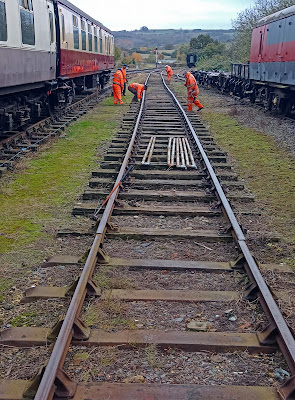







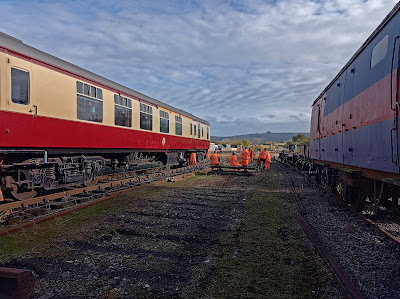


















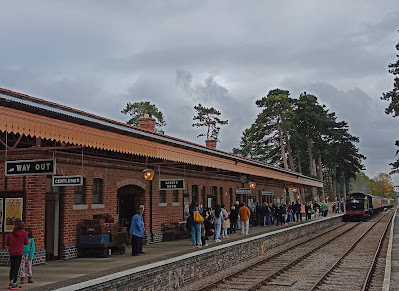





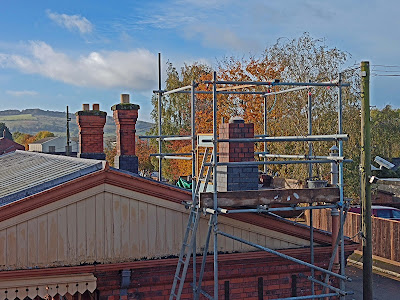
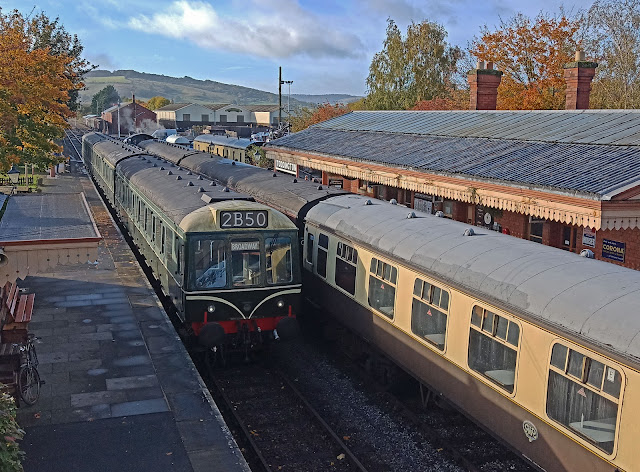








.jpg)




















